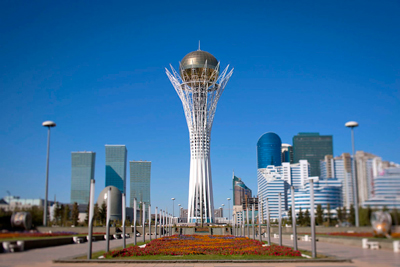
Located on the left bank of the River Ishim River, opposite the Presidential Residence and in the middle of Nurzhol Boulevard, Baiterek is a futuristic tower in Astana, the capital city of Kazakhstan and is emblematic of the city, which became the capital of the country in 1997 and a symbol of post-independence Kazakhstan. The Kazakh word bayterek literally stands for high or tall poplar, referring to the tree, which is appropriate for a national monument loaded with symbolism and inner meaning, connecting the primeval world with the modern age in a celebration of progress.
According to the Kazakh legendary version of the universe, bayterek is the Tree of Life that grows on the World River bank and in the crevice between two branches of the Tree of Life, lives Samruk, the magic bird of happiness. Every year, Samruk lays an egg, signifying the Sun, granting life and hope, which is later gobbled by Aydakhar, a wicked dragon that lives among the roots of the tree. Thus, the Kazakhs depicted the struggle between good and evil, the change of seasons, day and night and Bayterek, a folklore symbol, was embodied in the beautiful Baiterek Tower in Astana, signifying the eternal fight between good and evil and the connection between centuries, the past and the present of Kazakhstan.

According to ancient Turkic mythology, Baiterek, the Tree of Life, is the symbol of the three imaginary worlds. While the underground roots of the tree denote the Underworld, infested by evil spirits and devilry, where the wicked dragons and Bapa, the king of snakes, live with his family, the trunk of Baiterek is the Middle World, the land of living of the people and animals, heroes and the crooks, rich and the poor.
Finally, the top of the Baiterek is the Upper World, the holy land of divinity, where the deities and angels live. Samruk, the magical giant bird that lives in its nest in the tree, covers the sky with one wing and meets the sun at sunrise with another wing, The bird lays its egg in its nest signifying the Sun, a symbol of the eternal dawning life.

The idea of the construction of the Baiterek Tower is the brain child of the First President of Kazakhstan, Nursultan Nazarbayev, who .drew a sketch of his dream tower on a napkin during a flight, which is now stored in the Museum of the First President.
The project was also launched on his initiative, under the architect Akmurza Rustembekov, in celebration of the 10 years of independence of the former Soviet Union. Constructed as a symbol of the transfer of the capital from Alma-Ata to Astana in 1997, the Bayterek Tower was opened in the centre of the new capital of the country in 2002.

However, the construction of the unusual Baiterek Tower is unlike any other constructional work, it is more than just a unique artistic flourish. The whole construction weighs over 1,000 tons, while the weight of the sphere is about 300 tons. The 345 feet (105 m) tall tower, supported by 500 masts and made of iron, concrete and glass, rises from a wide flat base within a raised plaza and consists of a narrow cylindrical shaft, surrounded by white branch-like girders that flare out near the top, supporting a gold-mirrored 72 feet (22 m) diameter golden sphere, representing the egg of the Samruk, signifying the mythical sun, a symbol of the eternal dawning life, while the multiple pointed spires surrounding sphere signifies the nest of the mythical Samruk. The sphere on the top of the tower, made of chameleon glass that changes colour tone with the changes with sunbeams, was imported from Italy. Apart from that, all the materials used in the construction were produced in Kazakhstan.

Entrances to the Baiterek Tower are located below eye level, accessible by stairs from the surrounding plaza and the basement floor, around 15 feet (4.5 m) under the ground level, contains aquariums, Bayterek Gallery and a small café. The Baiterek Tower is equipped with a high speed Japanese elevator that silently moves along the trunk of the symbolic Tree of Life to lift the visitors to the observation deck, 318 feet (97 m) above ground level, consisting of two levels. While one offers a wonderful 360-degree panoramic view of the city and beyond, the higher level, accessible by a flight of stairs, contains a wooden globe with 17 petals, containing signatures of the 17 world religious leaders who came to Astana in 2003 and blessed the land and the people of Kazakhstan, symbolising the religious movements of the world. It also exhibits a gilded handprint of the right hand of Nursultan Nazarbayev, the first President of the Republic of Kazakhstan, mounted on an ornate pedestal.